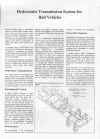Single car unit No: RDB 975385 (formerly a Cravens parcels
car No:M55997) was converted as a test bed for hydrostatic drive in 1980 and was
known as 'Laboratory 9 Hydra'.
Although the design philosophy of a rail vehicle fitted
with hydrostatic transmission Hydra had already been recognised, the mechanical
design considerations in producing an improved design of transmission for
increased mechanical reliability coupled with the inclusion of a hydrostatic
braking facility. These modifications have been incorporated in a re-built
transmission, two of which have been fitted to the test vehicle “HYDRA” to
create a totally hydrostatically driven vehicle.
The modifications also include fitting more powerful prime
movers to provide a more rigorous test of the transmission, auxiliary circuits
to power friction brakes and cooling fans, a hydraulically operated friction
brake, a microprocessor controller for the engine/transmission/brake package and
a computer controlled data acquisition system.
The hydrostatic transmission has undergone an extensive development and
endurance running program of up to 42,500km. Very few mechanical problems were
experienced, these being mainly due to defects in bought-in components. The
pressurised reservoir was however underspecified due
to the presence of a pressure peak not previously detected, so a suitable
replacement was designed. Endurance running revealed a weakness in the motor
design resulting in increased internal leakage. The problems arose too late to
allow a major investigation of the cause, but high standards had been maintained
to avoid oil contamination and it is thought the cause could be the unusual
conditions of use.
It was fitted with hydrostatic transmission having the normal
Leyland 680 six cylinder engine driving two Rexroth Hydromatic axial piston
pumps. Each pump supplied fluid to a Volvo fixed displacement compact axle-end
motor which drove the axle directly. The maximum system pressure was in the
order of 400 bar.
This arrangement was only fitted to one bogie, initially the other one
retaining its normal drive but with the cardan shaft disconnected but as
described above it was later modified
The unit was finally scrapped by Vic Berry at Leicester.
|





